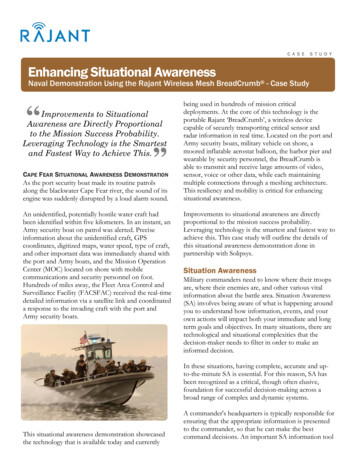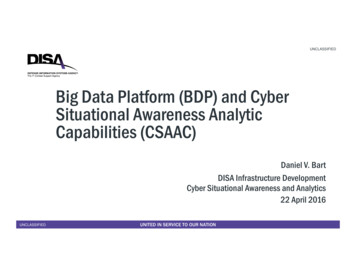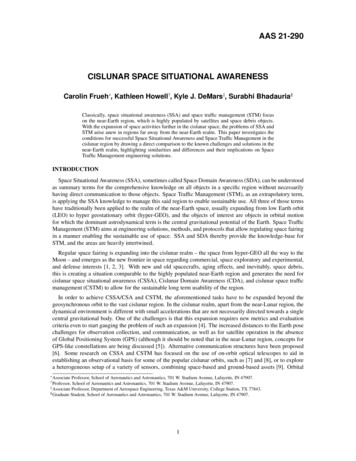
Transcription
Situational awarenessAligning business strategiesand tax planning forintellectual property
If you have an apple andI have an apple and weexchange these apples thenyou and I will still eachhave one apple. But if youhave an idea and I havean idea and we exchangethese ideas, then each of uswill have two ideas.–George Bernard Shaw2
Beyond patents,beyond taxFew companies can create value without relying on intellectualproperty (IP)—the often invisible assets they can’t weigh or lockin a safe, but which set them apart from their competitors.Business strategies that help build, protect, and monetize IP are acommon focus for large organizations. Too often, however, thesesame organizations neglect to align the way they manage their IPwith their global tax planning.Failing to address the tax implications of intangible assets canlead to very palpable consequences. Poorly structured IP management may cause profits to buildup in high-tax jurisdictions. Without careful planning, moving intangible assets acrossborders or among business entities may elevate transferpricing risks and tax liabilities. Mergers and acquisitions can leave IP in places where owningit costs too much and it delivers too little value. Poor planning of IP management, or poor documentation ofIP inventory and use, may invite regulatory challenges. Tax planning not attuned to the business may lead to costlygovernment challenges.The result can be not only a higher global tax burden, but alsolimited ability to make effective critical business decisions on anafter-tax basis.Few business leaders have the time to consider IP on its ownas an important business issue. They’re absorbed in the real-lifescenarios that determine the success of the company. Alright,then: What about those scenarios? In these pages, we’ll examinea few common examples and see how IP tax planning needs tobe part of the calculus.Situational awareness – Aligning business strategies and tax planning for intellectual property2
3
IP 101Many people think of intellectual property (IP) in terms of“trade secrets”—but if they do, they’re leaving a lot of othercategories out of their plans to measure, protect, and profitfrom the intangibles within their organizations.IP does include the kind of bona fide trade secrets you mightlock in your safe. Everyone has heard stories about the “secretrecipes” behind famous soft drink and fast food brands. ButIP also includes trade intangibles like patents, and designs, aswell as marketing assets like trademarks and brands. Workadayknow-how—the experience an executive or a workforce has ingetting the job done—can qualify as IP too.IP is not a static commodity. The role it plays, the costs itimposes, the benefits it offers, and the associated risks—allchange over its lifespan. IP may enter an organization atthe moment of its creation, as a direct purchase, or whenthe company acquires an asset that includes ownership ofthe IP. Like other assets, IP can depreciate over time withoutappropriate investments, though the means of calculating thatvalue erosion isn’t always as clear as with a tangible investment.And in the end, an organization can retire an IP asset, muchas it would a building or a piece of equipment. For example,IP can obsolesce, as technologies advance or change. Theconcept of the IP lifecycle is significant because it adds a timedimension to the way an organization considers and managesits intangible assets. This is not a decision you make once, but along-term plan that requires both foresight and agility.IP has value. There are numerous views that tax authoritieswill enumerate as their version of what that value is andwhat a company owes for owning, using, or transferring it.And the rules change frequently. The company that fails toidentify, value, and protect its IP legally may be opening itselfup to excess risk and leaving potential profit unrealized. Tomake IP work in the long-term, a company’s IP strategy, its taxplanning, its legal process and policies, and its business strategymust operate in alignment. Deploying the IP is an importantconsideration and a few options include granting the territorialownership to an affiliate or third party, licensing, and sharing inthe rights to it.Situational awareness – Aligning business strategies and tax planning for intellectual property4
Know-howIP is a broad category that includes elements that many peopleassociate with the term—like patents and trade secrets—alongwith components that some organizations may neglect toconsider, such as culture and tPracticesIntellectual PropertyOperationalGuidelinesby rule of law, or registrationInternalSoftwaree.g., Patents, Trademarks,Designs, Database rights,Copyrights, ionshipsLegallyProtectedKnow HowBrand ployeeKnow HowIndustrialOrganizationIntangibleFreeFlowing
Now, let’s look at somecommon IP scenarios—and how these principlesmay apply.Situational awareness – Aligning business strategies and tax planning for intellectual property6
What if 7
You’re engaged in M&A?When your organization and another come together, many partsneed to mesh. The longer that process of integration takes, theless efficient the deal will be. It’s not surprising that at a time likethis, many leaders focus attention on the tangible assets rightbefore their eyes, such as working to integrate people efficiently.But a merger or acquisition also has the effect of forcing twoseparate IP regimes to become one. If the resulting IP structuredoesn’t benefit from deliberate attention, it can be haphazardor worse. It might not support the tax planning and businessstrategies that brought the entities together in the first place.And you might find it locked into place.Handled well, the integration of IP after an M&A deal maybe a significant benefit. The new entity should have IP in theright places where it can help generate value, and everyoneinvolved should have a clear understanding of the taximplications. The location and use of the IP should line upwith the organization’s operating and ERP structure. And dueconsideration should be given to not just beneficial ownership,but legal ownership as well. These sometimes, but not always,will or should be the same.Handled poorly, post-M&A IP strategy can become a muddle thatenhances risk, decreases efficiency, contains redundancies, andelevates the global tax burden. There are decisions in integrationthat you get to make only once—and if an inefficient IP strategyis baked into the deal, it can be hard to fix later.In M&A, IP planning needs to be front and center—not only inintegration, but as part of the due diligence process. IP should bea factor in why the deal is happening and how.Situational awareness – Aligning business strategies and tax planning for intellectual property8
Key disciplinesM&AMergers and acquisitions can challenge a company’s strategy bythrowing new IP and structures into the mix—at various points intheir lifecycles, and in a way that’s seldom aligned with the strategicdecisions that already govern other intangibles. That means analyzingthe value of the IP, assessing its risks, and quantifying the potentialopportunities it represents. There will likely always be plenty of workremaining during post-merger integration. But ideally, the big IPdecisions will happen during due diligence and contribute to largescale decisions about the deal itself.9
You’re changing yourERP environment?Whether it’s an update or an overhaul, a revamped ERP systemwill fundamentally alter the way a supply chain moves throughan organization. Is your IP strategy aligned with that new supplychain? Or are you going to find out months from now that fortax purposes, you’re earning all your income in a high tax foreigncountry?Where supply chains are concerned, businesses need to apply atremendous amount of transfer pricing logic to the design of theirbusiness processes. That means knowing the rules of the road inand between the jurisdictions where you operate. Who owns theIP? How does it drive value? Who posts the profits when it does?How aggressive are the relevant taxing jurisdictions at play?When an ERP project takes IP into account, people ask thesequestions early in the process and build the answers into the logicof the new system. At a minimum, that adds clarity that can helpaddress excess taxation and manage risk. But the potential benefitsdon’t stop there: A sound IP component to ERP change can identifyareas of opportunity as well.Remember the old ‘Garbage in Garbage Out’ principle ofinformation systems? An ERP structure that doesn’t have IP strategybaked in may end up generating results that aren’t consistent witheffective IP practices. Your risk will most likely go up, as differentgovernments compete for your tax dollars and if you don’t have thedocumentation to sort out the liability.To maintain your profits properly and to allow your IP to generatevalue instead of costing you money, your information systemsshouldn’t treat intangibles as an afterthought.Situational awareness – Aligning business strategies and tax planning for intellectual property10
Key disciplinesTransfer pricingWhen related parts of a business use each other’s resources,tax authorities expect them to charge each other as if theywere separate companies operating “at arm’s length.” Failure toeffectively plan can lead to significant tax liabilities and risks ofdouble taxation. Anticipating and easing the burden of transferpricing starts with the way different parts of a business legallyrelate to one another and the ways in which ownership of therelevant IP is parceled out.For example, a business unit in one country may performmanufacturing functions for a business unit in anothercountry that imports the goods and sells them. The plans andspecifications, technical secrets, and know-how that go into themanufacturing process all represent IP. Who owns it—the parentcompany or the manufacturing arm? Does the manufacturingunit owe the other unit a royalty for using the IP? Or do theyown it jointly under a cost-sharing agreement?Today, the ability to transfer and apply IP instantly around theglobe using the internet adds complexity to these issues. Becausethis high-speed, high-volume information flow exists in thedigital “cloud” rather than in a distinct physical location, it invitesquestions about where the IP actually resides and whether or notit has actually traveled across a border.Obeying the law starts with knowing the law. And it’s changing,fast, in every jurisdiction where you do business, prompted byrecent projects on Intagibles and Base Erosion and Profit Shifting(BEPS) currently being addressed by the OECD.11
You’re recasting yourbusiness model?Sometimes it’s evolution: A computer hardware company mightfind itself emerging as a software leader or as a cloud serviceprovider. Sometimes it’s revolution: For example, health carereform has many hospitals and insurers re-examining whetherthey’re even in the same business anymore.Whatever the pace, a shift in business model changes everything.If you don’t account for IP as part of the process, the taximplications can go from dramatic to traumatic in a hurry.Once again, the answer is to include IP tax planning from theoutset. Take an inventory of your IP portfolio and business modelfrom scratch, as if you were starting a new business—because inmany ways, you are. What is it? Where is it? What am I delivering,and from where?Inconsistency means risk. If your business contracts support onetruth about IP and your IP strategy supports another, you may beat a disadvantage asserting your position to tax authorities.If your model going forward involves mobile or virtual services, itcan be unclear where the assets that support those services arelocated for tax purposes, or where the value-driving transactionstook place. The physical location of servers and other elements ofyour IT infrastructure can be key considerations, but not the onlyones. Contracts and customer relationships matter too. Sharedservice centers that support operations in multiple jurisdictions canmake the picture more complex.Situational awareness – Aligning business strategies and tax planning for intellectual property12
Key disciplinesBusiness Model OptimizationCreating value through business transformationThe alignment of a company’s operating model and its global taxplanning enhances the opportunity for value creation. Each mustadapt to satisfy the demands of the other. BMO is the process ofpursuing this balance and integrates the operating model withglobal tax planning into the way a business operates.Tax planning that is not based on operations can dramaticallyincrease the risk profile of a company. And a business modelthat does not take tax planning into account may end upsurrendering some or all of the profit it creates to higher taxes.The way an organization structures and locates the componentsof its business, and the way it sets relationships among them,can influence the way the IP contributes to value and the way inwhich taxing authorities view that contribution. Often, a processthat seems completely internal can actually “carry” IP acrossjurisdictional borders, incurring transfer pricing or other risksalong the way.Some of the basic IP structures are: Dispersed: The organization’s IP resides in a number ofdifferent locations Overlapping: Similar or identical functions implicating IPare taking place in multiple locations Regional: The IP resides in more than one location, but islimited to a few Centralized: The IP resides in a single location and units“use” it from thereIncome characterizationWhen an element of IP contributes to creating value, what kindof value is it? Is it capital gain, business income, or somethingelse? Were the IP rights acquired by means of sale or license(e.g., is the transaction recorded as an upfront payment or a longterm license stream?) The distinction can have a significant effecton the way the sum in question is taxed not limited to countries,yet state taxing jurisdictions as well.13
You’re developingnew IP?Even the simplest IP tax scenario—developing brand-newIP, outside the context of a merger or system change—isn’tnecessarily simple. Whether it’s a new pharmaceutical patent,a new software application or some other freshly mintedintangible asset, you theoretically have a clear path to makingall the right decisions. But will you?Traditionally, the party that takes the risks and incurs theexpense of developing IP is credited with the returns itgenerates, and is responsible for the taxes on those returns.However, there’s a growing global trend to also considerwhere the IP is managed, directed, or controlled.For example, India may seek to tax the profits associated withR&D activity within its borders even if the IP involved is ownedby investors in the United States who funded its creation.Other countries may alter their tax codes with the explicit aimof reducing IP tax burdens and encouraging innovation withintheir borders, as with the many “Patent Box” regimes comingon line in Europe.What this means for companies that develop IP is that it’smore important than in the past to coordinate the humanside of IP and tax planning. Where are your people? Wheredoes the IP “go” to make R&D happen? Who is participating inwhich phases of the process?Even if your approach doesn’t involve pursuing deliberateincentives like the Patent Box, it’s still vital to align yourorganization’s internal IP ownership structure with adistribution of personnel and functions that places taxableactivities in more desirable jurisdictions.Situational awareness – Aligning business strategies and tax planning for intellectual property14
Key disciplinesPeople strategyThe first group many think of when they think of IP is innovators.But in many cases they have the least to do with the property’splace in the business plan or its effect on tax status. The investorsand executives who work with the IP are usually more centralto both business strategy and tax planning, because they arethe ones required to manage the risks. But as certain countriesincrease their focus based on where the people and locationswhere IP is managed, organizations may benefit by shiftingsome of the calculus to other organizations—for examplecontractors—and into other tax jurisdictions where someoperations are located. It means the placement of individualpeople and business units may have more impact on both taxplanning and business strategy than in the past.AnalyticsIP taxation is a fertile field for analytical methods because itinvolves multiple rules and tax rates that exist at the same timeacross different jurisdictions, complex ways to calculate IPscurrent and future value, and an almost endless array of “whatifs” that make it hard to quantify the potential outcomes ofstrategy decisions.For example, using conventional means it can be difficult toestimate the market value of an IP asset being transferred, theexpected return an investor will be owed arising from operationsthat use IP or the tax liability on that profit.15
16
Now what?17
Process:Start at the beginningDeloitte’s business model optimization methodology can helpguide the realignment of IP planning so that business strategyand tax planning are in sync.Four simultaneous work streams—the “4Rs”—guide anorganization through realignment of the business model,reconfiguring of IT systems, readying the human resources,and reorganizing the structures that govern the relationshipsamong legal, finance, and tax regimes.These efforts progress through four phases—feasibility, design,implementation, maintenance and monitoring—to provide arigorous overall framework for integrated transformation ofbusiness, systems and tax.Not every IP planning project involves every facet of the4R methodology. It is a map, not a checklist. Using it,organization leaders and their advisors can determine that theright processes are in place as the business moves to designand implement consistent business and tax strategies.PhasesFeasibilityMaintenance ess ModelAnalysisDesignImplementationMaintenance &MonitoringWork StreamsRealigning for Business TransformationDefining and designing the new operating model and IP strategyReconfiguring IT SystemsAdapting the IT infrastructure to support the new business processesReadying Human ResourcesManaging the employee representation process, the movement of people,facilities and overall change managementReorganizing Legal, Finance and Tax StructuresReorganizing the legal entity structure and contractual relationships to preserve thenew operating model and related financial impactsProgram ManagementSituational awareness – Aligning business strategies and tax planning for intellectual property18
The 4R methodologyRealigning for business transformationAligning IP tax planning and business strategies may or may notbe part of a larger business model transformation. But everyorganization should make sure its business model is capable ofefficiently developing and deploying IP in the right ways. Thisis the groundwork for everything that follows so it is criticalthat the organization’s management, operations, and taxprofessionals (whether internal, external, or both) partner in thisassessment and design process.Reconfiguring IT systemsIT systems must be able to support governance structures,supply chains, and every other part of a business in harmony.IP is an essential part of this puzzle. Building this capability willtouch upon access to financial data, tax policies, transfer pricing,approval processes, and other issues.Readying human resourcesAligning strategies means changing functions, locations, andrisks. That can mean moving people, which has the potential totrigger attrition, disruption, and leadership confusion. The talentimplications of IP strategy can’t be ignored.Reorganizing for legal, finance, and tax structuresChanging the way valued assets move within and through acompany can lead to unforeseen changes in customs, taxes(both direct and indirect), and calculations about ownership andprofit. Organizations can’t leave these elements to chance.19
Conclusion:Don’t go it aloneAs businesses seek new ways to drive revenue and profitswhile effectively managing cash flow and costs, effective IPtax planning is a smart idea. It can help companies createsubstantial value while helping them address and managetax-related risks.But companies cannot consider IP strategy, tax planning, andbusiness strategy as separate items. They all work together.The way an organization arranges its internal structure canhave far-reaching effects on the tax liabilities that come withdeveloping and using intangible assets.Interactive tools like Deloitte’s Digital Global ST2EPS usesdescriptive analytics to help businesses identify focus areas intax planning and estimate the tax impact that can result fromdifferent scenarios—based on IP or on other considerations.The tax laws of the parent organization’s home countryare one place to start. It’s also vital to know the tax laws ofcountries in which subsidiaries operate or have a presence,and the transfer pricing activities that transpire betweenparent and subsidiaries. Similarly, it may be important tounderstand in what jurisdictions tax incentives may beavailable in the global business landscape.More than anything, it’s vital to have the right support. Asustainable, profitable, coherent approach to IP tax planning istoo complex for almost anyone to tackle alone.Situational awareness – Aligning business strategies and tax planning for intellectual property20
ContactsPlease contact one of our leaders to discuss yourspecific needs.Andrew C. NewmanBusiness Model Optimization –Co-Global Leader 1 312 486 9846acnewman@deloitte.comDavid CordovaBusiness Model Optimization –IP Leader 1 206 716 7527dcordova@deloitte.comMike GilsonBusiness Model Optimization –Supply Chain Leader 1 312 486 3240mgilson@deloitte.comJohn WellsBusiness Model Optimization –Transfer Pricing Leader 1 214 840 7558johnwells@deloitte.com
About DeloitteDeloitte refers to one or more of Deloitte Touche Tohmatsu Limited, a UK private company limited by guarantee, and itsnetwork of member firms, each of which is a legally separate and independent entity. Please see www.deloitte.com/aboutfor a detailed description of the legal structure of Deloitte Touche Tohmatsu Limited and its member firms.Deloitte provides audit, tax, consulting, and financial advisory services to public and private clients spanning multiple industries.With a globally connected network of member firms in more than 150 countries, Deloitte brings world-class capabilities andhigh-quality service to clients, delivering the insights they need to address their most complex business challenges. Deloitte hasin the region of 200,000 professionals, all committed to becoming the standard of excellence.This communication contains general information only, and none of Deloitte Touche Tohmatsu Limited, its member firms, ortheir related entities (collectively, the “Deloitte Network”) is, by means of this publication, rendering professional advice orservices. Before making any decision or taking any action that may affect your finances or your business, you should consult aqualified professional adviser. No entity in the Deloitte Network shall be responsible for any loss whatsoever sustained by anyperson who relies on this communication. 2014. For information, contact Deloitte Touche Tohmatsu Limited.
Situational awareness - Aligning business strategies and tax planning for intellectual property 4 Many people think of intellectual property (IP) in terms of "trade secrets"—but if they do, they're leaving a lot of other categories out of their plans to measure, protect, and profit from the intangibles within their organizations.










